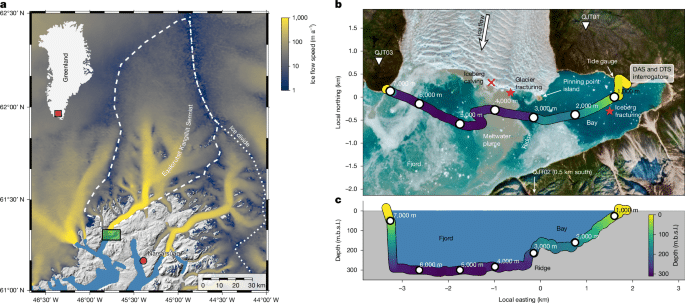A groundbreaking study is reshaping how scientists track icebergs as they break off from glaciers. Published in Nature, the research uses innovative fiber optic technology to capture every detail of iceberg calving in real time. With over 56,000 iceberg breakups documented in southern Greenland, this discovery unveils the hidden dynamics of glaciers as they melt beneath the surface. The team’s findings could significantly improve climate models, offering more precise data on sea level rise.
Unlocking the Secrets Beneath the Surface
The study, led by Dominik Gräff at the University of Washington, represents a significant leap forward in our understanding of glacier dynamics. Traditionally, scientists have struggled to gather detailed data on the process of calving, particularly below the water’s surface, where much of the critical action occurs.
“We don’t have much idea what’s actually going on below the water,” said Gräff.
However, by laying a 6-mile-long fiber optic cable across the seafloor of a fjord in southern Greenland, the team was able to listen from a safer distance and capture a wealth of real-time data that had previously been out of reach.
This innovative technology, which combines distributed acoustic sensing and temperature sensing, provided the team with a unique perspective on how icebergs break off from glaciers and drift away. The system turned the cable into thousands of vibration sensors, allowing the researchers to monitor every crack, wave, and underwater current associated with the calving process. As David Sutherland, a physical oceanographer at the University of Oregon, put it, “It can just sense everything.” This remarkable sensitivity allowed the team to detect tiny fractures long before they became visible to the naked eye.
Published in Nature, the findings are helping to fill a critical gap in our understanding of glacier dynamics. By providing detailed information on the ice loss process, the study is expected to enhance models that predict the rate of ice melt and its contribution to rising sea levels.

The Science Behind Fiber Optic Sensing
The key to this study’s success lies in the sophisticated technology used to monitor the glacier. By employing distributed acoustic sensing (DAS) and distributed temperature sensing (DTS), the research team turned an ordinary fiber optic cable into a powerful sensor array. DAS detects vibrations along the cable, capturing everything from the faintest cracks to the larger movements that occur as icebergs break free. DTS, on the other hand, continuously measures temperature along the fiber, revealing subtle changes in water conditions that could influence the rate of melt.
The integration of these two techniques allowed the team to capture an unprecedented level of detail, logging everything from the first micro-cracks in the ice to the final moments when the icebergs splinter and drift away. These data points also provided valuable insight into how underwater currents and waves influence the breakup of glaciers, offering a clearer picture of how the process works below the water’s surface.
For scientists, this represents a massive leap forward. As Gräff noted,
“There are very few seismological datasets where, within such a short amount of time, you record so many different phenomena.”
This level of detail is crucial in understanding the broader implications of iceberg calving, which plays a significant role in global sea level rise.
The Role of Ice Melting in Global Sea Level Rise
Understanding how icebergs break off glaciers is essential for predicting how glaciers will contribute to rising sea levels in the future. Traditionally, models have struggled to account for the complexities of iceberg calving, especially those happening beneath the surface of the water. The new data from the fiber optic cable helps bridge this gap, shedding light on the physical processes that drive ice melt and iceberg detachment.
One of the most important discoveries from the study is how the calving process can amplify melt beneath the glacier. The data revealed that calving events generate powerful waves and currents that stir the water, mixing different temperature layers and accelerating heat transfer to the ice face. This “mixing” effect, observed in both Greenland and Antarctica, shows how calving can increase the rate of underwater melt, helping to explain why some glaciers are melting faster than expected.
As Fichtner, a seismologist at ETH Zürich, put it, “It’s pretty remarkable” how the dataset reveals these complex interactions between icebergs, water, and the surrounding environment. These insights can now be incorporated into climate models to improve predictions of how glaciers will behave in the coming decades, offering critical information for understanding future sea level rise.
